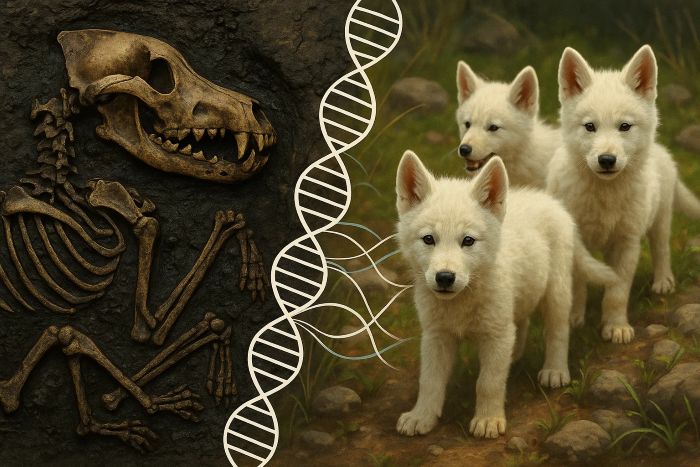The resurrection of dire wolves represents one of the most significant breakthroughs in genetic science and conservation biology. After disappearing from Earth approximately 12,500 years ago, these formidable Ice Age predators once again exist as living animals through techniques developed by Colossal Biosciences.
Unlike their fictional counterparts popularized in entertainment media, the actual dire wolves (Canis dirus) were specialized hunters that dominated North American ecosystems from approximately 250,000 to 13,000 years ago. Fossil evidence indicates they were larger than modern gray wolves, with adults weighing between 150-175 pounds and possessing distinctive adaptations for hunting Pleistocene megafauna.
The journey from fossil specimens to living animals began with extracting fragmented DNA from exceptionally preserved remains. Dr. Michael Reynolds, paleogeneticist with the project, describes the initial challenges: “Pleistocene specimens typically preserve only 2-3% of original genetic material. We needed computational modeling to reconstruct complete genomic sequences.”
Using specimens primarily from the La Brea Tar Pits in California, researchers identified crucial genetic markers that differentiated dire wolves from modern canids. Recent studies had already established that dire wolves represented a distinct evolutionary lineage that diverged from the ancestors of gray wolves approximately 5.7 million years ago—much earlier than previously thought.
The de-extinction methodology involved identifying eight critical gene sequences that determined unique dire wolf characteristics. Using CRISPR-Cas9 gene editing technology, scientists modified gray wolf embryos to express these traits, creating genomes functionally equivalent to dire wolves. These modified embryos were carried by surrogate mothers, resulting in the birth of three healthy pups named Romulus, Remus, and Khaleesi.
Dr. Elena Vasquez, lead veterinarian for the program, notes their physical development: “The pups display the robust skeletal structure, broad cranial morphology, and muscle development consistent with paleontological records. Their white coat coloration was perhaps the most surprising confirmation of our genetic work.”
This coat coloration represents a notable departure from fictional portrayals. Fossil evidence had suggested light-colored fur would provide optimal camouflage in the mixed grassland environments where dire wolves primarily hunted.
For Ben Lamm, founder and CEO of Colossal Biosciences, the achievement extends far beyond scientific curiosity. “The technologies developed through this program have immediate applications for endangered species today,” Lamm stated in recent press statements. “We’re already adapting these techniques to strengthen genetic diversity in critically endangered populations.”
Indeed, conservationists working with North American wolf populations have begun implementing techniques developed through the dire wolf program. The critically endangered red wolf, with fewer than 20 individuals remaining in the wild, represents an immediate application target. Genetic analysis of dire wolves revealed resilience mechanisms that could help modern species adapt to changing environments.
The wolves currently reside at a secured 2,000-acre facility with restricted access. No plans exist for wildlife reintroduction, though genetic material has been preserved for potential future conservation applications. The research focus remains studying these living specimens to bridge paleontological understanding with contemporary wildlife biology.
The revival has generated significant scientific interest across disciplines. Paleontologists gain unprecedented insights into behaviors previously limited to skeletal inference. Geneticists observe the expression of ancient genes in living organisms. Conservation biologists acquire new tools for preserving endangered species.
Perhaps most significantly, the dire wolf program demonstrates a profound shift in our relationship with extinction. What once represented permanent biological loss may now, in carefully selected cases, be temporary. This reframes conservation conversations toward possibilities previously considered beyond scientific reach.
For now, the world’s only living dire wolves remain under careful observation. Their health, behavior, and development provide data bridging paleontology and zoology in ways never before possible, writing a new chapter in our understanding of these ancient predators.





